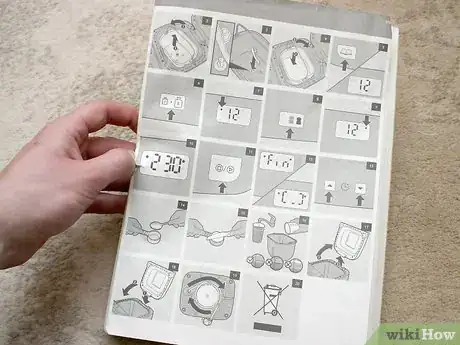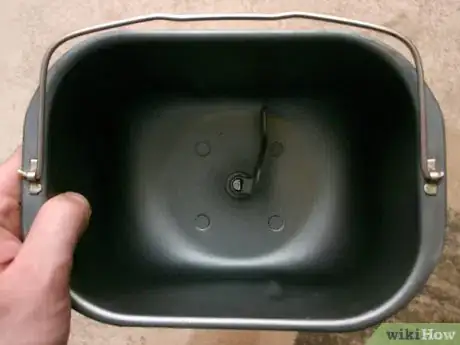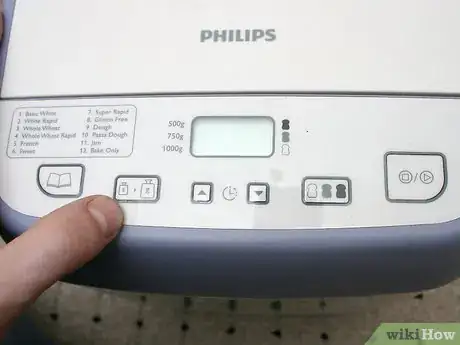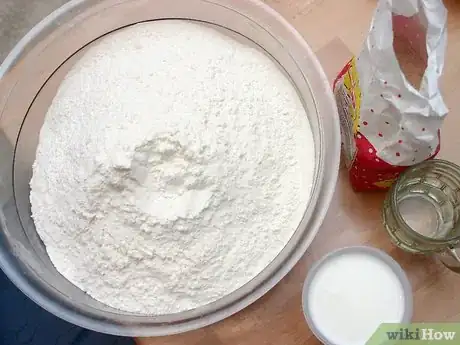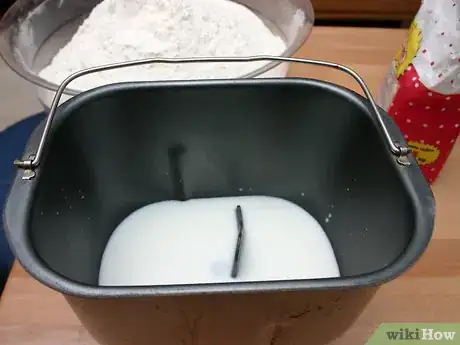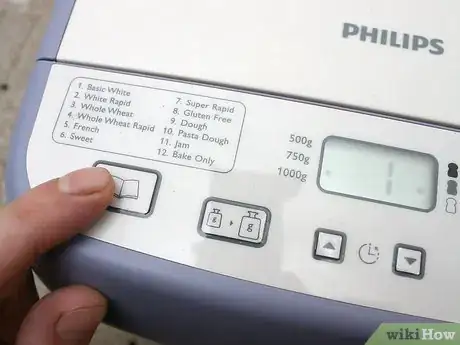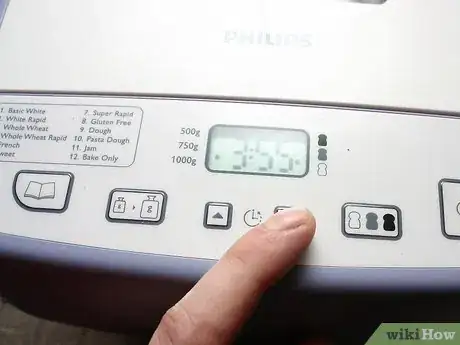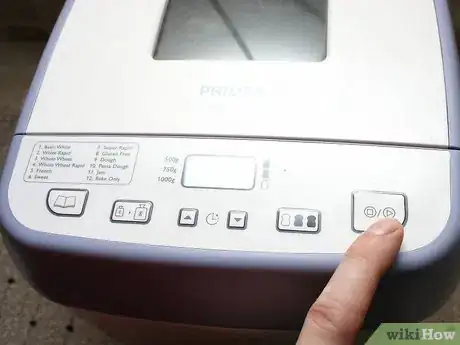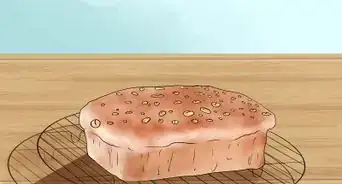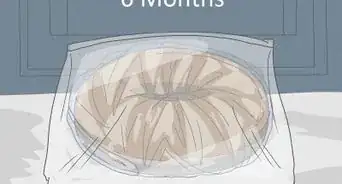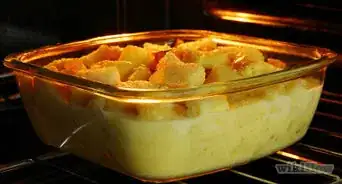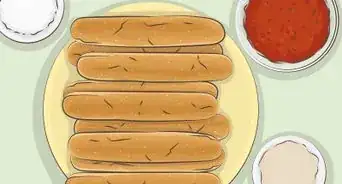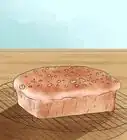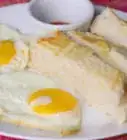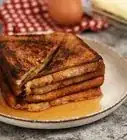wikiHow is a “wiki,” similar to Wikipedia, which means that many of our articles are co-written by multiple authors. To create this article, 15 people, some anonymous, worked to edit and improve it over time.
This article has been viewed 578,440 times.
Learn more...
Do you have a bread machine, but no manual, because you bought it at a yard sale, inherited it from a relative, or just lost the manual? Instead of storing it in a cabinet and adding to your "I'll use it someday..." clutter, get started making your very own fresh, toasty, delicious bread! See Step 1 below to get started.
Steps
-
1Get to know your machine. Take some time to inspect it. There is a hinged lid, which can be lifted and shut; there may be a window in it, and probably a small vent too. Next to the lid, you should see a control panel with a few buttons (and maybe a light or two if you have a fancy version). Inside the bread machine, there is a bread pan or bucket. There should be a handle on it, which is probably folded down so the lid will close. The bread bucket works as both the mixing bowl and the baking pan. In the center of the bread bucket will be a little bread paddle or kneading blade. It is responsible for kneading and mixing the dough. When the dough bakes, it bakes around the kneading blade. You must remove the blade from the bottom of the loaf after the bread is baked.
- You must have all three parts to make bread. The machine itself, the bread bucket, and the kneading blade. If any one of these parts is missing, you must replace it. The kneading blade is the smallest part and the one most likely to be missing. It is also the least expensive to replace. If you need replacement parts then do an Internet search to find the manufacturer of your machine. Go to their website and email them about what you need.
- The bread bucket and kneading blade are removable. To take the bread bucket out, your machine may require you to pull hard, depending on how it snaps in. Look it over, grab the handle, and pull. Don’t worry; you are not breaking it. After you get the bread pan out, examine it. If you turn it upside down, the kneading blade will fall out. There will be a peg inside the bread pan the kneading blade fits over. To put the bread bucket back into the machine and snap it into place, you may have to shove down hard. Yours may go in easily or you may have to turn the gear under the bread bucket just slightly to get it to fit into the machine the right way.
-
2Find out your bread bucket capacity. Take the bread bucket out set it next to the sink. Get a measuring cup and fill it with water. Pour the water into the bread bucket. Do it repeatedly, until the bucket is full. Count how many cups of water you are adding to the bucket, until you get a total. This part is important, so measure carefully. When you choose a recipe, it is important that you match it up to the size of the bread bucket you have. You would not want to make a 2 lb recipe in a 1 lb machine. It would result in a big mess.[1]
- If your bread bucket holds 10 cups of water then you can make 1-1/2 pound loaves of bread.
- If your bread bucket holds 12 cups or more than you can make 2 pound loaves of bread.
- If your bucket holds less than 10 cups then you can make 1 pound loaves of bread.
Advertisement -
3Become familiar with the settings. Have a good look at the buttons and display screen on the control panel. You will probably find a Select button, a Stop/Start button, Crust Color and Timer or Arrow buttons. Unplug your machine. Plug it back in. The machine will be on its Basic (or default) setting now.[2]
- Close to the select button you will see several choices. The most common ones are White or Basic; Whole Wheat; French; Sweet; Rapid, & Dough. To set the machine to a particular cycle you have to keep pressing the Select button until it gets to the cycle you want. Sometimes a number identifies each cycle. For instance, White or Basic is usually 1. Whole Wheat is 2. French is 3; and so on; you get the idea. Each cycle takes a different amount of time to mix and cook the bread.
- The crust setting is not available on all machines. If you do see a button labeled Crust then it will have 3 settings available: Light, Medium & Dark. The default setting is medium. When you unplug the machine and then plug it back in, it will automatically set itself to the medium setting. If you prefer a light or dark crust instead, then you press the Crust button to change the setting. Usually the Crust button will not work until after you select the dough cycle and before you press Start.
- Using the timer is described in a separate section, below.
-
4Get your ingredients. There are a few basic ingredients you need to make bread in a bread machine. They are yeast, flour, salt, sugar, liquids and fats.[3]
- Yeast used in a bread machine should always be labeled “Active Dry” on the label. Sometimes you can buy yeast in a jar that says it is specifically for bread machines. Packets of yeast, available in the baking aisle of the grocery store, usually hold 2-1/4 teaspoons of active dry yeast. You may use one packet of yeast to replace 2 teaspoons of yeast in most bread machine recipes. The extra 1/4 teaspoon of yeast won’t make that much difference. Don’t use rapid rise yeast. It's not worth the extra cost, and the time savings is negligible once you get the hand of making bread.[4]
- Bread flour makes better bread. Bread flour is made from hard wheat so it has more gluten, or wheat protein, in it than regular all-purpose flour. All-purpose flour is a blend of hard and soft wheat. This makes it serviceable for biscuits, cakes and quick breads, which prefer soft wheat flour; and serviceable for yeast bread, which prefers hard wheat flour. It is called all-purpose flour because it is designed to be used for all baking purposes. Bread flour is made for yeast bread. If you do not have bread flour then you may use all-purpose flour for most bread recipes. Your results will not be the same as if you had used bread flour, but you will still have good results, and you will still get good bread. Sometimes you will need to add a tiny bit more flour to your dough if you use all-purpose flour. This is not always true but it is sometimes.
- Salt is a necessary ingredient in machine made bread. It regulates the rising process so the bread dough does not spill over the bread bucket into the machine. Salt also adds flavor to the bread. Bread made without salt does not taste as good as bread made with some salt.
- Sugar, honey and other sweeteners soften the texture of the dough and the finished loaf. They also contribute to the browning of the bread and the crispness of the crust. The main role they play, though, is as easy-to-use-food for the yeast. Yeast can use the starch in flour for its food but it is much happier if it gets an easy to use food like sugar or honey. Most bread machine recipes call for at least a small amount of sugar. However, bread machine breads do best if they do not have too much sugar added to them. When making sweet dough from scratch it is not unusual to add a full cup of sugar to the dough. When making sweet dough in the machine,, though it is better to use 1/4 to 1/2-cup of sugar or honey at the most. This is because the dough rises faster and higher in a bread machine than it does when prepared by hand. Too much sugar is too much food for the yeast and it gets over-excited. This can result in a machine made mess that is unpleasant to clean up.
- Liquids used in a bread machine should be room temperature or a little bit warmer. You should never use hot liquids in a bread machine. Liquids that are too hot will kill the yeast. Room temperature liquids make the yeast happy. If you are using tap water then warm tap water is fine. If you are using yogurt or buttermilk you may want to take it out of the fridge to warm up a bit before you use it in the bread machine. (This is not strictly necessary, especially for breads baked on the Basic Cycle or longer. If you are using the Rapid Cycle though it is important the liquids be warm or at least at room temperature.)
- Fats make the finished loaf richer, softer, and keep the dough from sticking to the non-stick surface of the bread pan. Usually between 1 and 4-tablespoons of fat are used in a 2 lb loaf of bread machine dough. You can use most fats interchangeably in a bread machine. Margarine, oil, shortening, lard, chicken fat, bacon grease or butter will all give you the same results. Some of the fats will add a different flavor, and the texture of the bread will change slightly, depending on which type of fat you use. Solid fats do not have to be melted before adding them to the bread machine. It helps if they are at room temperature, but this is not always practical.
-
5Add the ingredients in the right order. If you are going to mix and bake the dough right away then it does not matter which order you add the ingredients. If you want to program the machine with the Delay Cycle to start while you are away, then the order becomes important. The ingredients must be added in a way that will keep them inert until the machine begins its mixing. Therefore it is a good idea to get in the habit of adding the ingredients in this way from the beginning.[5]
- Put the liquids into the machine first.
- Next add the flour. As you are adding the flour, urge it out over the top of the water so it seals the water in.
- Then you can add the other dry ingredients like salt, sugar, dry milk powder and seasonings.
- The last thing you should add is the yeast. Most recipes suggest that you make a shallow indentation or well in the center of the flour and sprinkle the yeast into it. This is important because it prevents the yeast from touching the liquid until the machine begins mixing. If the yeast and liquid get together before the machine is scheduled to begin, then the yeast will become active and likely make a big mess out of the machine.
Using the Timer
-
1Put your ingredients in the bread pan and snap the bread pan into place.[6]
- Use a recipe that you have already tested and that you trust.
- Place the ingredients into the bread bucket in the correct order, as described above.
-
2Select the cycle you prefer.
-
3Using math, figure out how much time before you want the loaf to be finished baking.
-
4Use the arrow buttons to adjust the time on the display screen to match the number of hours you figured out above.[7]
-
5Close everything up and press Start. Walk away now, and let it do its magic.
Community Q&A
-
QuestionSometimes the dough comes out very sticky. Am I adding too much or not enough of an ingredient?
 Community AnswerTry adding more flour to your mix to firm the dough.
Community AnswerTry adding more flour to your mix to firm the dough. -
QuestionCan I look into my bread machine while the bread is baking?
 CuriouscocoCommunity AnswerYes, you can to check how it looks or if the dough is rising enough.
CuriouscocoCommunity AnswerYes, you can to check how it looks or if the dough is rising enough. -
QuestionWhen would you stop the bread machine if you want to finish it on the oven?
 Community AnswerIf you use the dough cycle, you will be able to take it out of the machine, form it into rolls or a loaf, let rise until double, then bake. Bake in a glass pan at 425ºF for about 24 minutes. You can use any standard bread recipes; just ignore instructions in regular recipes, except for the list of ingredients, temperature and time for baking. Be sure to put the ingredients in your machine with liquids first, flour second, then salt, then sweetener, then yeast. Remove the dough when the dough cycle is done, form it into a loaf or rolls, let rise till doubled. Bake in the oven according to recipe's instructions.
Community AnswerIf you use the dough cycle, you will be able to take it out of the machine, form it into rolls or a loaf, let rise until double, then bake. Bake in a glass pan at 425ºF for about 24 minutes. You can use any standard bread recipes; just ignore instructions in regular recipes, except for the list of ingredients, temperature and time for baking. Be sure to put the ingredients in your machine with liquids first, flour second, then salt, then sweetener, then yeast. Remove the dough when the dough cycle is done, form it into a loaf or rolls, let rise till doubled. Bake in the oven according to recipe's instructions.
References
- ↑ https://www.hillbillyhousewife.com/breadmachinemanual.htm
- ↑ https://www.hillbillyhousewife.com/breadmachinemanual.htm
- ↑ https://www.tasteofhome.com/recipes/basic-homemade-bread/
- ↑ https://www.breadmachinediva.com/2017/03/what-is-bread-machine-yeast/
- ↑ http://dish.allrecipes.com/bread-machine-baking-the-basics/
- ↑ https://www.youtube.com/watch?v=tKf1U0lSST8
- ↑ https://www.youtube.com/watch?v=tKf1U0lSST8
About This Article
To use a bread machine, start by adding all of your ingredients to the bread pan, including yeast, flour, salt, sugar, and whatever liquids and fats you'll be using. Then, snap the bread pan into place and choose a cycle, like white or whole wheat, by pressing the select button until you get to the cycle you want. Finally, close your bread machine and press the start button so it starts making your bread. To learn how to use the delayed timer setting on a bread machine, scroll down!
